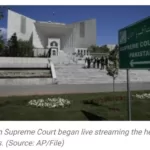A Constitution bench presided over by Chief Justice of India D.Y. Chandrachud, has scheduled hearings starting October 17 to examine a cluster of petitions contesting the constitutionality of Section 6A of the Citizenship Act, 1955.
Section 6A, a unique provision, was integrated into the 1955 Act as a result of the ‘Assam Accord,’ a Memorandum of Settlement signed on August 15, 1985. This historic agreement, brokered by the then Rajiv Gandhi administration, aimed to safeguard and preserve the cultural, linguistic, and social identity of the Assamese populace. It marked the culmination of a strenuous six-year-long agitation led by the All Assam Students Union to identify and repatriate illegal immigrants, predominantly hailing from neighboring Bangladesh, residing in the state.
The Union government staunchly defends the validity of Section 6A and has beseeched the court to reject the petitions, which have surfaced nearly four decades after the enactment of this provision.
Under the aegis of Section 6A, foreigners who had entered Assam before January 1, 1966, and established “ordinary residency” in the state, were accorded all the privileges and responsibilities of Indian citizens. Those who arrived in the state between January 1, 1966, and March 25, 1971, received the same rights and duties, albeit with a 10-year voting restriction.
Challengers contend that Section 6A exhibits a “discriminatory” nature in granting citizenship to immigrants, particularly illegal ones. They argue that this special provision contravenes Article 6 of the Constitution, which established the cut-off date for granting citizenship to immigrants as July 19, 1948.
One party in this legal saga, the Assam Sanmilita Mahasangha, a civil society organization based in Guwahati, has urged the revision of the National Register of Citizens (NRC) for Assam. They advocate reliance on the 1951 NRC instead of the electoral rolls of March 1971.
Back in December 2014, the Supreme Court framed a series of 13 questions, delving into diverse issues surrounding the constitutionality of Section 6A. These questions spanned concerns such as whether the provision diluted the “political rights of the citizens of the State of Assam,” whether it infringed upon the rights of the Assamese people to conserve their cultural heritage, and whether the influx of illegal migrants in India constituted ‘external aggression’ and ‘internal disturbance,’ among others.
In 2015, a three-judge Bench of the Supreme Court referred this intricate case to a Constitution Bench, where it has remained for several years. Throughout this period, the Section 6A case has awaited its moment, even as the Supreme Court oversaw the preparation and release of the final Assam NRC list in August 2019, a process marked by the exclusion of over 19 lakh individuals. These years also witnessed the enactment of the contentious Citizenship (Amendment) Act, offering expedited citizenship to immigrants belonging to minority communities in Afghanistan, Bangladesh, and Pakistan.
The impending deliberations on Section 6A promise to be a significant legal milestone, as they traverse the intersection of constitutional principles, historical accords, and contemporary immigration dynamics, with potential ramifications for the nation at large.




